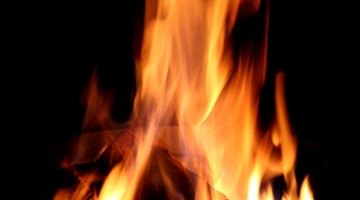The Disadvantages of Compressed Air Foam Systems
Compressed air foam systems (CAFS) deliver fire extinguishing foam to retard fires. They release thick blankets of foam that completely blanket fires. CAFS systems use one of two forms: class A and class B foams. Class A foams are designed specifically for wood fuel fires, and class B foams extinguish flammable and combustible liquid fires. Compressed Air Foam Systems are effective in eliminating fires, but they are associated with some cost, environmental and health disadvantages.
High Costs

According to Jeff Stern and J. Gordon Routley in the book "Class A Foam for Structural Firefighting," CAFS systems are costly to purchase, implement and maintain. Equipment, staff training and the foam add to the cost of the CAFS system. According to the U.S. Department of Homeland Security, full-size CAFS units cost a minimum of $35,000 and liquid foam concentrates cost $10 per gallon in September 2010.
Environmental Impacts
Foams used in compressed air foam systems are liable to run off and pollute drinking water, streams and affect wildlife. According to Jeff Stern and J. Gordon Routley, the long-term environmental impacts of compressed air foam systems remain uncertain.
According to a report published by the U.S. Fire Administration, titled "Special Report: Trends and Hazards in Firefighter Training," class B foams are considered hazardous waste after their intended firefighting use. Firefighting foams can contaminate both surface and ground water, necessitating treatment. The foams can disrupt wastewater plants and pump stations, causing raw sewage to back up or discharge.
According to Norbert Gibson in the book "Hazards XV," firefighting foams are harmful to aquatic environment due to their chemical makeup and their potential to discolor water courses.
Equipment Failures and Manual Errors
CAFS systems have complex computerized equipment that are susceptible to failures, causing huge property losses. Manual errors, such as using type A foam in type B tanks and type B foam in type A tanks, can seriously damage the components of foam systems.
Health Hazards
Class A foams are mixtures of solvents, surfactants, hydrocarbons and corrosion inhibitors. According to the U.S. Department of Homeland Security, class A foam concentrates are hazardous material that can cause eye and skin irritation on contact and irritate the upper respiratory tract. Foam concentrates can cause slipping hazards to firefighters. Foams are also susceptible to rupture, putting firefighters at risk of burnback.
Corrosion
According to Jeff Stern and J. Gordon Routley, class A foams are corrosive and are liable to rust metal equipment, pumps and tanks. Their concentrate damages the finish and paint on fire equipment and apparatus. According to the U.S. Department of Homeland Security, class A foams damage leather products.
References
- WFR: Class A Foam MSDS
- "Hazards XV"; Norbert Gibson; 2000 (Pg 12)
- "Class A Foam for Structural Firefighting"; Jeff Stern and J. Gordon Routley; 1997 (Pg 19)
- U.S. Forest Service: Compact Compressed Air Foam Systems
- US Fire Administration: Trends and Hazards in Firefighting Training
Writer Bio
Natasha Gilani has been a writer since 2004, with work appearing in various online publications. She is also a member of the Canadian Writers Association. Gilani holds a Master of Business Administration in finance and an honors Bachelor of Science in information technology from the University of Peshawar, Pakistan.
Photo Credits
- fire image by Fotocie from Fotolia.com
More Articles



